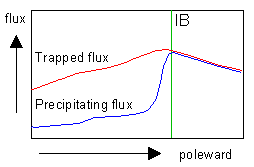 Isotropic boundary, IB
Isotropic boundary, IB
spaceweb@oulu.fi - last update: 4 September 1996, 1015 UT (RR)
Introduction
 Observations of precipitating (Jp) and trapped (Jt) energetic (> 30 keV) particle
fluxes at the ionospheric altitudes within the
auroral oval region has
revealed the existence of a sharp boundary
separating the poleward zone of isotropic
precipitation (Jp = Jt) from the equatorward
zone of weak loss cone filling (Jp << Jt) at all
local times (Sergeev and Malkov, 1988). By
definition, this boundary is called the isotropic
boundary, IB. They have been studied mainly
using the NOAA satellites in polar orbit at the altitude of about 800 km.
Observations of precipitating (Jp) and trapped (Jt) energetic (> 30 keV) particle
fluxes at the ionospheric altitudes within the
auroral oval region has
revealed the existence of a sharp boundary
separating the poleward zone of isotropic
precipitation (Jp = Jt) from the equatorward
zone of weak loss cone filling (Jp << Jt) at all
local times (Sergeev and Malkov, 1988). By
definition, this boundary is called the isotropic
boundary, IB. They have been studied mainly
using the NOAA satellites in polar orbit at the altitude of about 800 km.
Sometimes, especially after substorms, a region of rather intense proton
precipitation is observed equatorward of IB (Gvozdevsky et al., 1997). These regions have
been called low-latitude proton precipitation (LLPP) regions.
Characteristics
Basic characteristics of isotropic boundaries are (Sergeev et al., 1993):
- Separate boundaries can be found for electrons and protons
- electron IB is located at higher latitudes than proton IB
- Boundary position is inversely related to particle rigidity G
- boundaries for higher energy particles are located at lower latitudes than
boundaries for lower energy particles
- Inside the isotropic zone, the degree of the loss cone filling does not depend critically
on the absolute value of particle flux
- i.e., the ration Jp/Jt remains nearly constant.
- A distinct noon-midnight asymmetry can be seen
- the IB position moves towards higher latitudes near noon
- the electron IB is rarely seen at dayside.
- During higher magnetospheric activity, the IB position moves towards lower latitudes
at all local times
Mechanism
High precipitation fluxes at the top of the ionosphere indicate efficient scattering of particles
into the narrow loss cone in the magnetosphere. Although fluctuating electric and magnetic
fields could produce the needed pitch angle scattering, the more probable mechanisms for
isotropic boundaries is the tail current sheet scattering (TCS). It is based on the fact
that magnetic field lines at higher latitudes have increasingly non-dipolar shape which,
together with non-zero particle gyroradius, leads to non-adiabatic (stochastic) particle
motion at the equator in the central plasma sheet. The isotropic boundary is thus the
boundary between the inner magnetospheric region of adiabatic particle motion, and the
outer region of stochastic particle motion in the equatorial tail current sheet. The IB
characteristics listed above agree with this interpretation.
The threshold condition for strong pitch angle scattering to the center of loss cone is R/r
< 8, where R is the curvature radius of the field line, and r the effective particle gyroradius,
G/Bz. It can be shown that R/r depends strongly on particle rigidigy G and equatorial Bz.
Applications
The dependance of IB position of equatorial Bz makes it a potential remote sensing tool
for equatorial magnetic field from low altitudes. In addition,
the isotropic boundary analysis can be used to map the auroral oval down to the
magnetosphere by comparing the IB positions with lower energy auroral precipitation
regions. The IB of >30 keV protons is found in the diffuse region (equatorward half of the
oval) on the nightside, and equatorward of the intense auroral precipitation at dayside and
dusk. On the other hand, the IB of >30 keV electrons on the nightside is often found in the
structured precipitation region (poleward half), or just equatorward from it. (Yahnin et al.,
ICS-3). This implies that the diffuse aurora map to the dipole-like region close to Earth,
while discrete auroras map to the current sheet region (Bz < 5 nT). Arcs are often found in
wide latitudinal range, most likely covering both near-Earth plasma sheet and PSBL.
Common feature in all cases is the small Bz value indicating current sheet precense.
References
- Gvodzdevsky, B. B., V. A. Sergeev, and K. Mursula,
Long lasting energetic proton precipitation in the inner magnetosphere after substorms,
J. Geophys. Res., 102, 24333-24338, 1997.
- Sergeev, V. A. and M. V. Malkov, Diagnostics of the magnetic configuration of the
plasma layer from measurements of energetic electrons above the ionosphere,
Geomagn. Aeron., 28, 549-, 1988.
- Sergeev, V. A., M. Malkov, and K. Mursula, Testing the isotropic boundary
algorithm method to evalueat the magnetic field configuration in the tail, J. Geophys.
Res., 98, 7609-7620, 1993.
See also:
 Isotropic boundary, IB
Isotropic boundary, IB Isotropic boundary, IB
Isotropic boundary, IB Observations of precipitating (Jp) and trapped (Jt) energetic (> 30 keV) particle
fluxes at the ionospheric altitudes within the
auroral oval region has
revealed the existence of a sharp boundary
separating the poleward zone of isotropic
precipitation (Jp = Jt) from the equatorward
zone of weak loss cone filling (Jp << Jt) at all
local times (Sergeev and Malkov, 1988). By
definition, this boundary is called the isotropic
boundary, IB. They have been studied mainly
using the NOAA satellites in polar orbit at the altitude of about 800 km.
Observations of precipitating (Jp) and trapped (Jt) energetic (> 30 keV) particle
fluxes at the ionospheric altitudes within the
auroral oval region has
revealed the existence of a sharp boundary
separating the poleward zone of isotropic
precipitation (Jp = Jt) from the equatorward
zone of weak loss cone filling (Jp << Jt) at all
local times (Sergeev and Malkov, 1988). By
definition, this boundary is called the isotropic
boundary, IB. They have been studied mainly
using the NOAA satellites in polar orbit at the altitude of about 800 km.